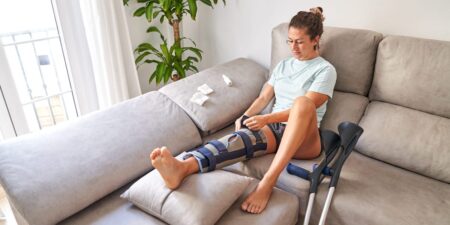- Steppin is the latest app by Kayak’s cofounder, Paul English.
- The app limits phone use by encouraging users to clock steps to unlock screen time.
- I tried it out for a week, and I noticed it made a difference in my morning routine.
For the past few years, I’ve set similar New Year’s resolutions to reduce my screen time. I’ve tried setting time limits, keeping my phone out of sight, and deleting social media apps.
None of them ever worked. With an average daily screen time of over five hours, I’m what fellow Gen Zers might call chronically online. And social media, not surprisingly, takes up the biggest chunk of my time.
When I learned that a new iOS app called Steppin — created by the Kayak cofounder Paul English — aims to help people “escape the scroll,” I was intrigued.
I tested the app for a week
Steppin combines the goals of clocking steps and limiting screen time. The more steps you take, the more time you are granted to use your restricted apps.
Each user can set their own parameters. I decided to restrict two of my most time-draining apps: Instagram and TikTok. For every 100 steps taken, I granted myself one minute of usage on my restricted apps. My earned time would reset every day.
I spent my first day working from home.
Normally, I use my evenings to unwind by scrolling social media. But on that day, by 5 p.m., I had only tracked 200 steps. With only two minutes to scroll, I decided to walk to a nearby park instead.
When I was done, I had walked more than 2,000 steps, the equivalent of 20 minutes of screen time. Seeing the number jump on the app gave me a dopamine rush.
At the end of the day, I had built up credit and could choose how much of my earned time to spend on my restricted apps.
I used the app for a week. The biggest change was that I stopped scrolling social media as soon as I woke up; I couldn’t, because I hadn’t clocked the required steps for that day. I felt refreshed and ended up with more productive mornings.
By the end of the week, my average screen time dropped by almost two hours.
How it works
Steppin is not the first app designed to curb screen time. The Qustodio parental app, released in 2012, allows parents to block apps and set daily screen time limits. Forest, released the following year, grows virtual trees during focus sessions. If users leave the app, the tree starts to die.
There are also built-in apps that allow users to set daily limits. Apple Screen Time is a feature on iPhones, and Digital Wellbeing, developed by Google, is on most Android devices.
Paul English, the CEO of Boston Venture Studio and the cofounder of the travel search engine Kayak, told Business Insider the idea for Steppin was sparked on a family trip to Spain.
During the trip, English’s then-fiancée, Rachel Cohen, and his son, Mike English, discussed ways to reduce screen time.
He credited the other two for the idea. “The idea really came from Michael and Rachel more than me. I was really excited about that and I said, we gotta do this, let’s build it, let’s build it, let’s put a team together because I think it’s a really good idea,” English said.
“There should be something outside of your phone to manage a phone addiction,” the younger English, 29, a product manager and designer at Boston Venture Studio, told BI.
“Walking is obviously something that almost everybody does. So that felt like a perfect combination of physical and mental well-being,” he said of the inspiration behind the app.
The app was released last month and is free on the App Store, although they are planning to charge an annual subscription fee of around $20. Steppin is not yet available on Google Play, but Android users can sign up for its waitlist.
“We have several thousand downloads, which is great since we just released the app a couple weeks ago and we have not started any marketing yet,” the elder English said. He declined to give a specific download count.
Why Steppin might — or might not — work
Pamela Rutledge, a media psychologist and the director of the Media Psychology Research Center, an independent research organization in California, said that Steppin could appeal to users who enjoy setting short-term goals with immediate rewards.
Assuming that screen time is a “high-reward” activity, pairing it with a “good for you” behavior can help people overcome inertia, she told BI. “This app might act as a gentle reminder to get moving, but more importantly, it breaks habitual behaviors and shifts attention,” she added.
But Rutledge said that the app’s effectiveness will depend on the user’s motivations, adding that users may become frustrated or lose interest once its novelty wears off.
Some experts also expressed concerns about a feature that allows users to override screen time restrictions in emergencies.
Melissa Hunt, a clinical psychologist at the University of Pennsylvania, said the app might be effective initially in making people more aware of their screen time by helping them be mindful, she said. “But overall, technology solutions to technology problems are always going to be inherently problematic,” she said.
Mike English said the option to override restrictions was included to give users more flexibility.
It took self-discipline to stop myself from overriding restrictions when I ran out of earned time. But being restricted from using social media didn’t stop me from fiddling with my phone when I had nothing to do. I found myself gravitating to other apps — and usually ended up at NYT Games to play rounds of “Spelling Bee.”
Read the full article here
















